Mississippi, home to 15 unique lizard species, hosts both native and invasive reptiles. These lizards are mostly active from spring through fall, while winter typically sees them in a state of inactivity. If you’re aware of the right places and times to look, these creatures can be easily observed across the diverse habitats of Mississippi.
Lizards showcase an array of colors, sizes, and body shapes. By understanding their behavior, physical features, and preferred regions, you can successfully distinguish between the different species. However, some lizards bear striking resemblances to one another, requiring a keen eye for accurate identification.
Join us as we embark on a fascinating journey through the world of lizards in Mississippi, exploring the unique characteristics of all 15 species that call this state their home.
Table of Contents
Lizards in Mississippi
1. Six-lined Racerunner
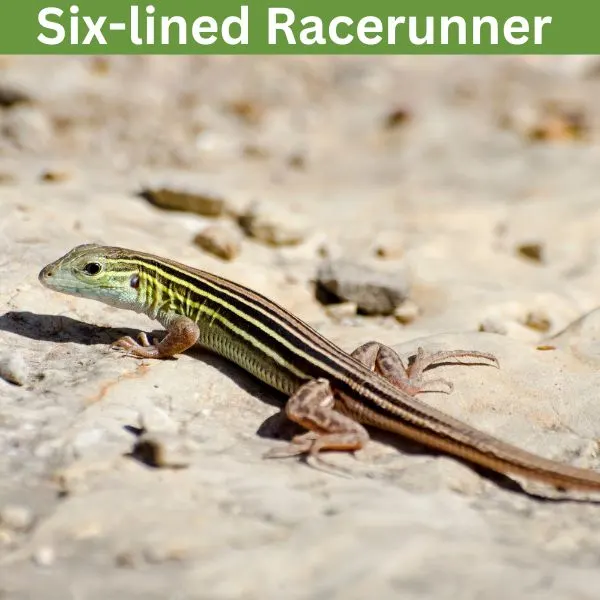
- Experience Level: Intermediate
- Family: Teiidae
- Scientific Name: Aspidoscelis sexlineata
- Other Names: Sandlapper lizard
- Adult Size: 6 to 9.5 in. (15 to 24 cm.)
- Lifespan: 4 to 5 years
- Average Price Range: $30
The six-lined racerunner is the only type of racerunner that lives in Mississippi, and the eastern United States. This species can be found across Mississippi, and are often seen in dry woodland, and grassland habitats. Active on warm days, at night this species rests in a sandy burrow.
This lizard is named after the six lines that run across its back, which are yellow. They have a tan, brown, black, or olive color, with a long tail. They have a slender appearance, with sharp claws. Their coloring and stirpes helped them blend into dry environments.
When not active this lizard is in a burrow that also helps them escape threats. Females lay their eggs in burrows, and they also use them to escape predators. When born this lizard has green bodies and blue tails.
During the morning, these lizards hunt, and also basks on rocks. They use chemical cues to navigate their world. Insects are what they feed on, using chemicals to track prey.
2. Green Anole
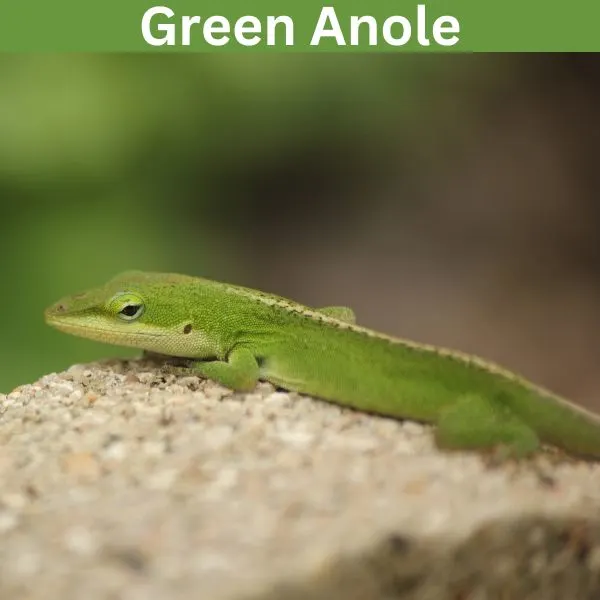
- Experience Level: Beginner
- Family: Dactyloidae
- Scientific Name: Anolis carolinensis
- Other Names: American anole, Red-throated anole
- Adult Size: 5 to 8 in. (12.7 to 20.32 cm.)
- Lifespan: 5 to 8 years
- Average Price Range: $10
Green anoles are found across Mississippi and are common in the southeastern United States. You can find this species in urban areas, parks, woodlands, coastal forests, and in man-made buildings. Warm and humid enviroments are where they prefer to live. They are regularly seen climbing trees or hiding under natural vegetation.
Green anoles have pointed heads and slender bodies. They have a vibrant green coloring, sometimes brown. This species has a pink throat, that is more prominent in males. Their tails are very long, sometimes twice as long as their body. The color of this species may change to better suit its environment.
Like a chameleon, the green anole waits for prey to cross its path, then pounces. They hunt during the day, feeding on anything they find. The population, and status of green anoles are stable globally, and they are one of the most regularly seen species in the warm season.
3. Brown Anole

- Experience Level: Beginner
- Family: Dactyloidae
- Scientific Name: Anolis sagrei
- Other Names: Bahaman Anole, Cuban Brown Anole
- Adult Size: 5 to 9 in. (12 to 22.86 cm)
- Lifespan: 5 years
- Average Price Range: $10
Brown anoles are an invasive species in Mississippi. They are native to Cuba, and the Bahama islands, and have been introduced to several regions around the world including the United States. Brown anoles are not common across Mississippi, but this lizard has managed to establish populations in some southern counties. The ability to survive in most habitats is why this is a common invasive species.
Tan, dark brown, or black is the color the brown anole appears in. They have a dewlap under their chin that can have orange coloring. Anoles are also able to change their colors to be darker or lighter. Markings of stripes or spots appear on this species.
Brown anoles eat insects, spiders, eggs, and other invertebrates. The ability to steal food and territory is why this species can be a threat to other lizards. Larger lizards, birds, rodents, and small mammals are the predators that this lizards are eaten by.
4. Slender Glass Lizard
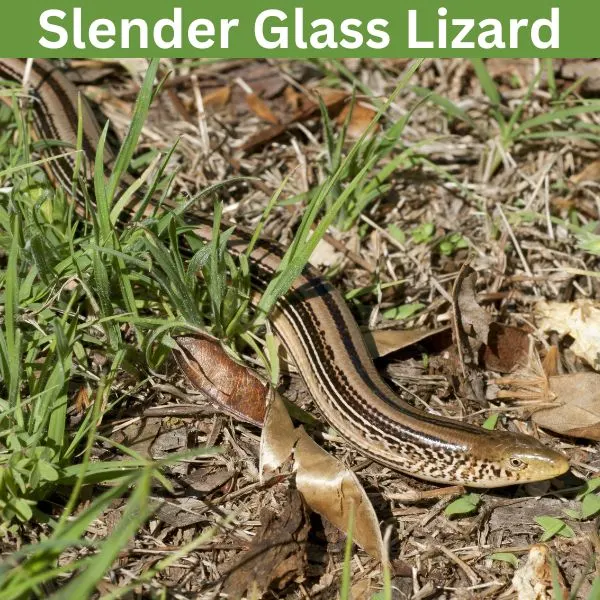
- Experience Level: Intermediate
- Family: Anguidae
- Scientific Name: Ophisaurus attenuatus
- Other Names: n/a
- Adult Size: 22 to 46 in. (55.88 to 116.84 cm.)
- Lifespan: 10 to 30 years
- Average Price Range: $50
Slender glass lizards are found across Mississippi. They mainly live in pine savannas and sandhill habitats. The slender glass lizard is listed as a stable species but is endangered in some of their range within the United States. The slender glass lizards’ secretive nature and burrowing ability make them a hard species to study.
What makes glass lizards unique is their legless bodies and snake-like appearance. Unlike snakes, these reptiles have earholes, and blinkable eyelids, along with no fangs. Slender glass lizards are the longest lizards in the state and have yellowish, or brown bodies. They may have stripes, or specks on them.
Slender glass lizards feed on insects, spiders, other reptiles, and any other thing that can fit into their mouth. Their jaws are not detachable like a snake. Birds of prey, mesopredator mammals, and snakes are the biggest threats to this lizard. They are also victims of habitat loss and may become endangered in the future since they rely on specific habitats.
5. Mimic Glass Lizard
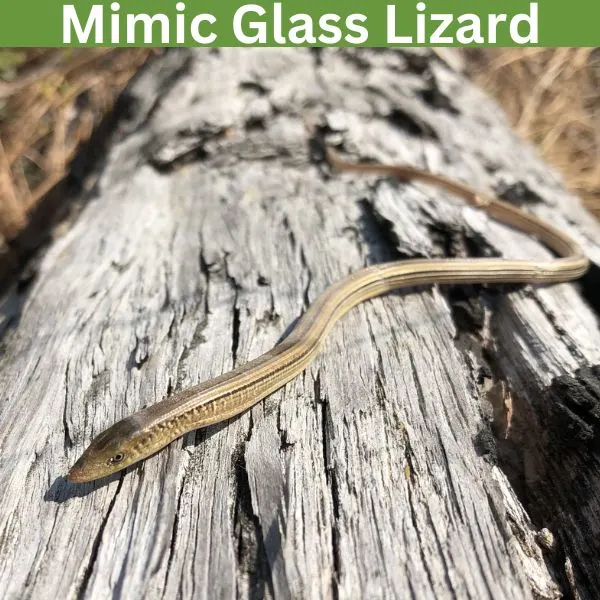
- Experience Level: Intermediate
- Family: Anguidae
- Scientific Name: Ophisaurus mimicus
- Other Names: n/a
- Adult Size: 15 to 26 in. ( 38 to 66 cm.)
- Lifespan: 10 to 30 years
- Average Price Range: $50
The mimic glass lizard has a range within the southeastern coast of the United States. In Mississippi this species is rare, mainly found in pine savanna and sandhill habitats. Mimic glass lizards are poorly studied, and further research is needed to understand their overall range.
This lizard is legless and has a body like a snake. They are smaller than other glass lizard species in Mississippi and have a brown, or yellow color. This species has dark stripes running down the sides of its body and a dark dorsal stripe that can help distinguish them from other glass lizards.
Summer is when the mimic glass lizard is believed to lay eggs. They spend their days feeding on insects, and other invertebrate prey. If attacked this lizard may drop its tail, which grows back slowly over time.
6. Eastern Glass Lizard
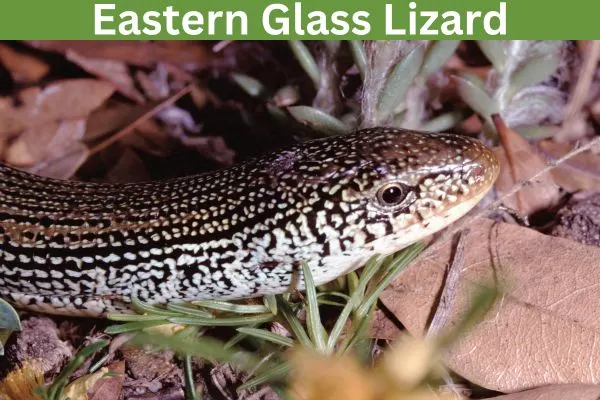
- Experience Level: Intermediate
- Family: Phrynosomatidae
- Scientific Name: Sceloporus consobrinus
- Other Names: Southern Prairie Lizard
- Adult Size: 22 to 46 in. (55.88 to 116.84 cm.)
- Lifespan: n/a
- Average Price Range: n/a
The eastern glass lizard is found in southern Mississippi. They live in pine forests, wetlands, and moist grasslands habitats. Active in the day, this lizard is often seen resting under debris like logs, or thick vegetation. The overall range of this lizard covers the eastern coast from Mississippi to North Carolina.
Eastern glass lizards have slender snake-like body. They have tan, brown, yellow, or greenish coloring. Younger lizards may have more colors, while older lizards become more simple colored.
Eastern glass lizards can drop their tail if handled, or frightened. They prefer warmer environments and are active during the day to feed on insects. This lizard like others will lose its tail if scared.
7. Prairie Lizard

- Experience Level: Intermediate
- Family: Phrynosomatidae
- Scientific Name: Sceloporus consobrinus
- Other Names: Southern Prairie Lizard
- Adult Size: 4 to 7 in. (10.16 to 17.78 cm.)
- Lifespan: n/a
- Average Price Range: n/a
The prairie lizard is a species found in the United States, sometimes seen in Mississippi. Prairie lizards live in open woodlands and urban habitats. They are active most from March until October and are regularly seen on sunny days. Males can be territorial with other lizards, especially in the breeding season.
The prairie lizard is a small species with roughly keeled brown or gray skin. They have reddish, tan, or orangish markings on their back. The outer belly and neck of this lizard are a blue iridescent color.
The day is when this lizard forages for insects to eat. They are climbers, sometimes seen on rocks, trees, or fences. Winter is when this lizard is not seen, and they overwinter underground or in natural debris. This lizard has a stable population and is one of the most common to see.
8. Eastern Fence Lizard
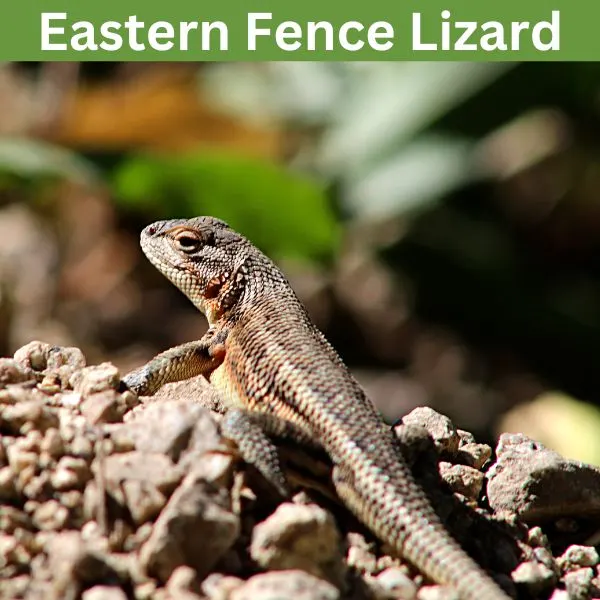
- Experience Level: Intermediate
- Family: Phrynosomatidae
- Scientific Name: Sceloporus undulatus
- Other Names: Prairie lizard, fence swift, pine lizard, gray lizard
- Adult Size: 4 to 7.25 in. (10.16 to 18.41 cm.)
- Lifespan: 4 years
- Average Price Range: $20
Eastern fence lizards have a large range that covers the eastern United States. This species may be seen in grasslands, woodlands, and urban habitats. These lizards are able to better survive in cold environments due to their larger eggs, and shorter incubation period.
Eastern fence lizards are tan, gray, or black colored. They are small, sometimes with a wavy dark pattern appearing on their back. This species has long thin fingers, with a long and thin tail. In the breeding season, males have bright blue coloring under their chin and the sides of their bellies, which are believed to help them attract a mate.
On the ground, on fences, or in trees are places you may spot this lizard during the day. They are one of the most arboreal lizards in Mississippi, and also sometimes use large rocks, or logs to hide under. Small insects, spiders, and other types of invertebrates are what this lizard eats.
9. Little Brown Skink
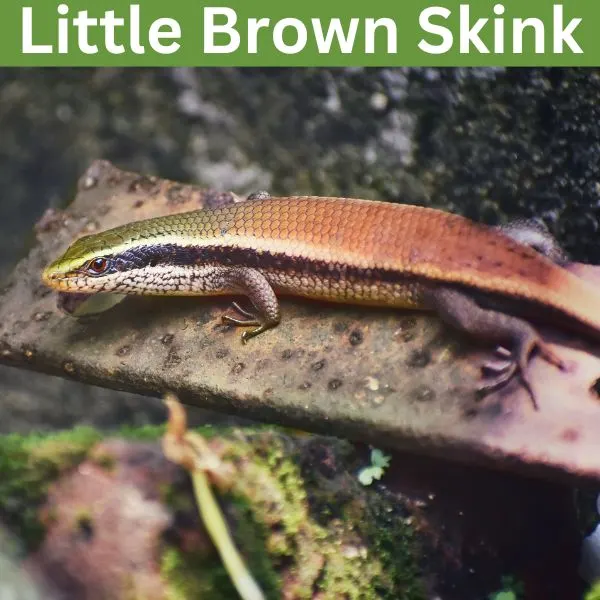
- Experience Level: Beginner
- Family: Scincidae
- Scientific Name: Scincella lateralis
- Other Names: Ground Skink, Brown-backed Skink
- Adult Size: 3 to 5.25 in. (7.62 to 13.3 cm.)
- Lifespan: 2.5 years
- Average Price Range: $5
In Mississippi, the little brown skink is found all over the state and is one of the most common lizards. Woodlands, swamps, and urban places are where this lizard lives. They are native to the southeastern half of the United States. Little brown skinks are fossorial, spending their lives in loose dirt, or leaf litter. They are not seen often climbing trees but may come out during the day looking for food.
This small lizard is thin and named after its tan coloring. They are one of the smallest lizards in North America and have a dark stripe that runs down their sides. Their may be dark specks that appear on this species body. Their belly has a white, gray, or yellosish coloring.
Little brown skinks feed on small insects, spiders, milipedes, and other small invertebrates they find in the soil. These skinks are very fragile, and their tails come off very easily if frightened. Various bird species, smaller mammals, large insects and spiders are what feed on this lizard.
10. Coal Skink
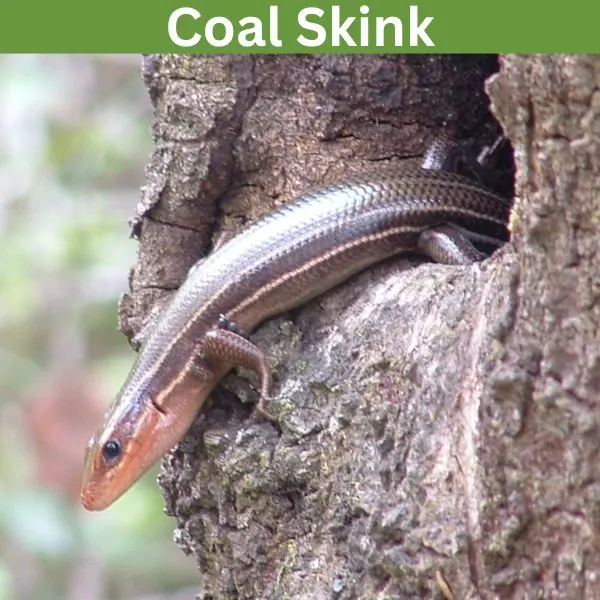
- Experience Level: Intermediate
- Family: Scincidae
- Scientific Name: Plestiodon anthracinus
- Other Names: n/a
- Adult Size: 5.1 to 7.1 in. (13 to 18 cm.)
- Lifespan: 6 years
- Average Price Range: n/a
Coal skinks are a species native to North America. These lizards have a scattered population across Mississippi. They live in open forests, woodlands, and rocky hillsides. Moist areas near springs, or rivers are where this species prefers to live.
Coal skinks are medium-sized lizards, with a slender body and short legs. They have tan, or grayish colroing, with a dark stripe that appears on their sides. Dark specks appear on their body.
Spring is when this species mates, and they lay around 5 to 9 eggs. This lizard guards their eggs until they hach in the summer. Like other lizards if mishandled this species will drop its tail defensively. Coal skinks feed on insects like grasshoppers, caterpillars, and other invertebrates like spiders.
11. Common Five-lined Skink
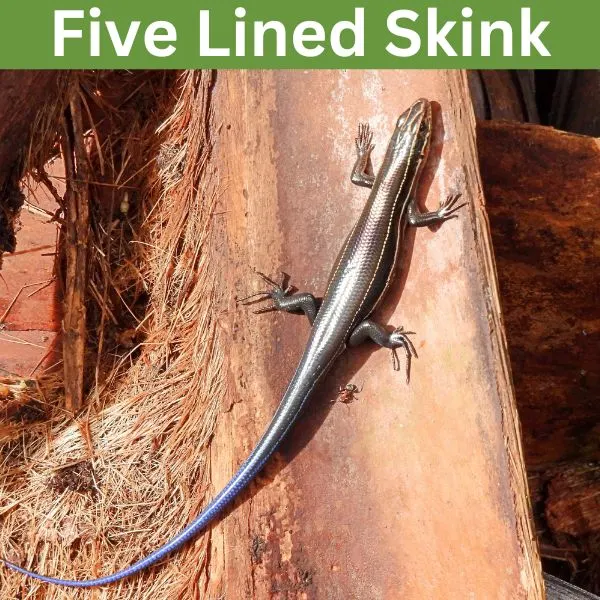
- Experience Level: Intermediate
- Family: Scincidae
- Scientific Name: Plestiodon fasciatus
- Other Names: American
- Adult Size: 4.9 to 8.5 in. (12.5 to 21.5 cm)
- Lifespan: 6 years
- Average Price Range: $12
The common five-lined skink is found across Mississippi. They are seen in most of the state, found in swamps, urban areas, and woodlands. Moist habitats with lots of trees, leaf litter, and other natural debris is where this species prefers to live. Near rivers, and bottomless forests are common places this lizard is found.
The common five-lined skink is named after the five lined markings that appears on their back. As juveniles this species has a bright blue tail, which typically fades away as they age. Common five-lined skinks have a black, tan, or olive color. Males in the breeding seasons can also develop bright reddish markings on their heads to attract mates. This lizard may look very similar to other skink species, and is identifiable by looking at enlarged scaldes near their tail.
Common five-lined skinks are seen often both on the ground, or climbing on things like trees. They also hide under debris like logs, rocks, or leaves when not active. Skinks are active in the day, spending this time looking for small insects to feed on.
12. Southeastern Five-lined Skink
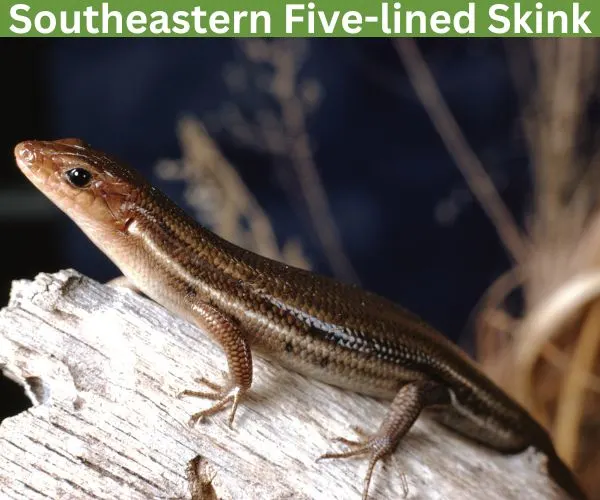
- Experience Level: Beginner
- Family: Scincidae
- Scientific Name: Plestiodon inexpectatus
- Other Names: n/a
- Adult Size: 5.5 to 8.5 in. (13.97 to 21.59 cm.)
- Lifespan: 6 years
- Average Price Range: n/a
The southeastern five-lined skinks are native to the south eastern Unitd States. This species lives in woodlands, grasslands, and pine forests habitats. They climb both on trees, and dwell on the ground. When breeding this lizard lays their eggs in secluded areas, hidden in vegetation. They guard their eggs until they hatch in the summer.
Southeastern five-lined skinks are named after the lined pattern on them. They have tan, or black coloring, with cream, or yellowish lines covering them. Their tails are blue when born, and their vibrant colrong fades to be more dull as they age.
Like other lizards this species is able to drop its tail. The blue coloring on their tail when young is said to help protect from fatal predator attacks. Insects, spiders, and other invertebrates are what this lizard eats. They are common in their range, and active most from spring to the end of summer.
13. Broadhead Skink

- Experience Level: Intermediate
- Family: Scincidae
- Scientific Name: Plestiodon laticeps
- Other Names: Broadhead Skink, Red-headed Scorpion
- Adult Size: 5.9 to 13 in. (15 to 33 cm.)
- Lifespan: 4 to 8 years
- Average Price Range: n/a
The broadhead skink is found in all of Mississippi. They are an arboreal species, living in oak trees, and woodland habitats. When active males will guard their trees, to defend their territory. These lizards spend their day foraging for food, looking through foliage.
Broadhead skinks are one of the largest lizards in Mississippi, and are named after their large head. They have tan, to olive green coloring, with their head having a bright red coloring. Their underside is a pale plain.
Broadhead skinks use nearby trees to lay their eggs, and hide from predators like birds or mammals. They are able to lose their tail, and if approached will flee.
14. Mediterranean House Gecko
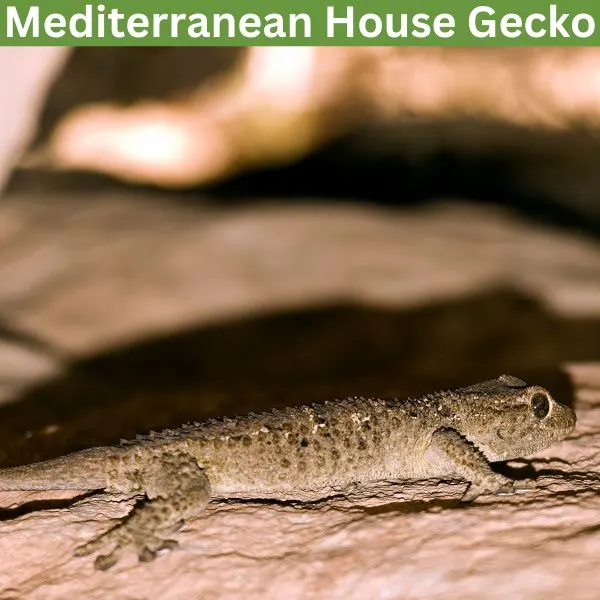
- Experience Level: Beginners
- Family: Gekkonidae
- Scientific Name: Hemidactylus turcicus
- Other Names: Moon Lizard, Turkish Gecko
- Adult Size: 4 to 5 in. (10 to 13 cm.)
- Lifespan: 3 to 9 years
- Average Price Range: $10
The Mediterranean house gecko is not native to Mississippi, but like their name suggests they are local to the Mediterranean region. Also called the moon lizard, this species mainly comes out in the night. Urban areas are common places this species is found, and they often live near buildings, and man-made structures.
A small lizard, this species has a tan, or cream coloring. They have yellow elipctial eyes, with brown, yellow, and cream markings covering them. Their skin is very bumpy, and their tails are long with a barred pattern.
Mediterranean house geckos feed mainly on insects, and scurry in the night to hunt. Crickets, spiders, rocahces, snails, and moths are a few of the things they eat. They create high pitched calls that help them mark their territory from other geckos.
15. Spotted House Gecko

- Experience Level: Intermediate
- Family: Gekkonidae
- Scientific Name: Hemidactylus parvimaculatus
- Other Names: Sri Lankan House Gecko
- Adult Size: 3 to 6 in. (7.62 to 15.24 cm.)
- Lifespan: 7 years
- Average Price Range: n/a
Spotted house geckos are not native to Mississippi, but have been sighted in some urban areas within the state. Asia, and the Middle East is where this species is originally native to, and they live in rocky habitats. Spotted house geckos are are able to live in tropical habitats with lots of humidity.
Spotted house geckos have a pinkish, or tan coloring. They are covered in dark brown spots, and have a granular appearance. Spotted house geckos are large yellow elliptical eyes, and have excellent night vision.
Active at night, this lizard spends its time hunting for insects to feed on. Being invasive resources like food and territory this lizard takes may cause other local species to suffer.
Questions About Mississippi Lizards
What are the invasive lizard species in Mississippi?
The brown anole, spotted house gecko, and Mediterranean house gecko are the invasive lizard species that live in Mississippi. Lizards become invasive to new areas and can travel to new places by hitching rides on shipped goods, or humans can even release them into the wild. If not controlled invasive species can overtake the resources used by native lizards.
Are the lizards in Mississippi dangerous?
There are no poisonous lizards in Mississippi, and these reptiles are typically harmless to humans. The biggest threat of a lizard is the germs they carry, so you should always wash your hands if handling one. Lizards may bite, but most have small teeth that do little damage.
What are the big lizards in Mississippi?
There are several big lizards in Mississippi like the eastern glass lizard, mimic glass lizard, slender glass lizards, coal skinks, and the broadhead skink. What determines a lizard’s size is its sex, age, and species. The majority of lizards in Mississippi are medium-sized or smaller.
Wrapping up
Lizards are one of the few reptiles that you may find in Mississippi, others including turtles, snakes, and even alligators. Lizards may be small, but help control pest insect populations. They are also used as a food source by animals like rats, birds, snakes, and large spiders.
The lizard species in Mississippi rely on essential habitats like woodlands, and wetlands that should be preserved in order to preserve the species that live on them. Population decline in lizards can occur from humans taking lizards from the wild, habitat destruction, and pollution.
While some lizards make good pets, you should learn as much as you can to be a knowledgeable owner if you plan on keeping any species as a pet. Lizards can be great beginner pets if you have the right species and personalities. The Mississippi lizards are found around the state, oftentimes in urban areas.
Other lizards in nearby states
